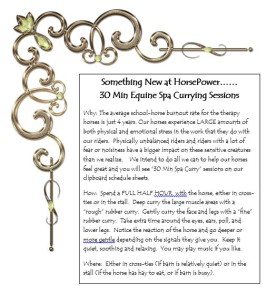One of the best sessions I attended at the 2015 PATH Intl Conference was “Grooming for the Healthy Horse” by BJ Hartmann of Miracle Farm Rescue about incorporate equine acupressure and massage into grooming. She explained everything in a way that you or I or our volunteers could do at home. The best part is, it’s basically what we do while grooming anyway, just with more awareness and intention toward helping the horse feel better. Read all the way to the end for the Spa part!
Grooming for the Healthy Horse
Concepts
Based on acupressure concepts, “meridians” carry the energy flow of the horse from the ears, along the neck and back, down the legs to the hooves, and vice versa. Energy has many possible definitions – electricity, air, blood flow – but whatever it is, there’s something to it. Reaction in any meridian spot could signify issues in that area, or a connected area or organ. If a horse reacts (lifts head, tenses neck, pins ears, bites, moves away, etc.) stay in that area until he relaxes (head down, licks and chews, snorts). You may need to groom lighter and eventually work in a deeper massage. If the horse is excitable, groom/pet counterclockwise, which is said to be calming.
In therapeutic riding, we already surround and bother the horse a lot, so in attempt to prevent further issues, we tend to leave their face and legs alone. Yet horses move their ears all the time, and eat all day, and stand on their legs all day, so the head and leg muscles are quite likely to get sore! Also, the meridians start and end at the head and legs. So to address potentially tense muscles, and to keep energy flowing, we need to groom the head and legs!
Grooming Exercise
If you have only 10 minutes, do this and spend a little more time on problem spots. Use a nice gel hand mat curry.
- Release the forehead and jaws
- For horses with mouth and bit problems, massage the corners of their mouth.
- If they twitch when you rub in the hollow under the bone behind the eye, they may have TMJ issues, so lightly jiggle the lower jaw.
- Curry the face.
- For sensitive ears, take your time and rub itty bitty circles all the way around their ears to release those muscles.
- If the eyes are blinky or reactive, rub the front corners.
- Work their forehead muscles according to how they like – circles, across, up/down, rubs, scratches, etc.
- Curry down the topline aka bladder meridian – neck, back, haunches.
- The muscle fibers mostly run front to back (click here for a pic). Some horses find currying with the fibers to be annoying, and will really enjoy currying across the fibers. Very your technique until you find what he likes.
- When working on a problem muscle, massaging it will be like working your hand into a bucket of sand. You have to start light and work your way in before getting deeper and working harder. AKA don’t just push.
- Curry the forehand – neck, shoulders, forelegs.
- Use cross fiber currying across these.
- Blood runs down the outside of the leg and back up the inside, so to increase circulation, curry in that direction.
- Buff/massage the coronary bands, all the way around behind the hoof.
- Curry the pectoral muscles – his chest.
- Massage his chest, where the girth goes, and between his legs.
- The chest muscles all come together like a sling here, and often get hurt or sore from being girthed too tight.
- Use very little pressure at first in case they are sore, until they relax, then increase the pressure.
- Curry down the butt and hind legs.
- The hamstring attached under the tail and run down into the hock. It’s the pushing muscle and often gets sore. A crooked tail signified a tight hamstring on that side. Tail rubbing can actually be the horse trying to massage their hamstrings.
- Again, start with less pressure and work to more.
- Again, curry down the outside of the leg and back up the inside.
- Curry the stifle and inner upper leg.
- Sometimes stiff legs can be from a sore groin muscle, pulled in pasture frolicking.
- Brush using a hard or soft brush.
- Brush the way your usually do.
- This works like the massage stroke “effleurage,” which brings blood to the surface of the muscle.
- Make notes about where the horse was reactive. A trend may indicate something to be looked into further by a vet and equine masseuse.
The Equine Spa Curry Session
My friend Carrie Capes of Horsepower TR has already starting putting these concepts into practice with her volunteers at home! She is asking her volunteers, when they have some down time, to spend time just currying their horses. She even made up this info sheet for their bulletin board, which explains it in a much more volunteer-friendly way than my notes above : )
To see the image bigger, click on it. Or to download the Word Doc for use yourself, click here: Grooming – Equine Spa Currying Sessions
Thanks so much for sharing, Carrie! And thank you BJ for your wonderful presentation!
****************
Note: This is not professional advice, this is a blog. I am not liable for what you do with or how you use this information. The activities explained in this blog may not be fit for every rider, riding instructor, or riding center depending on their current condition and resources. Use your best personal judgment!
